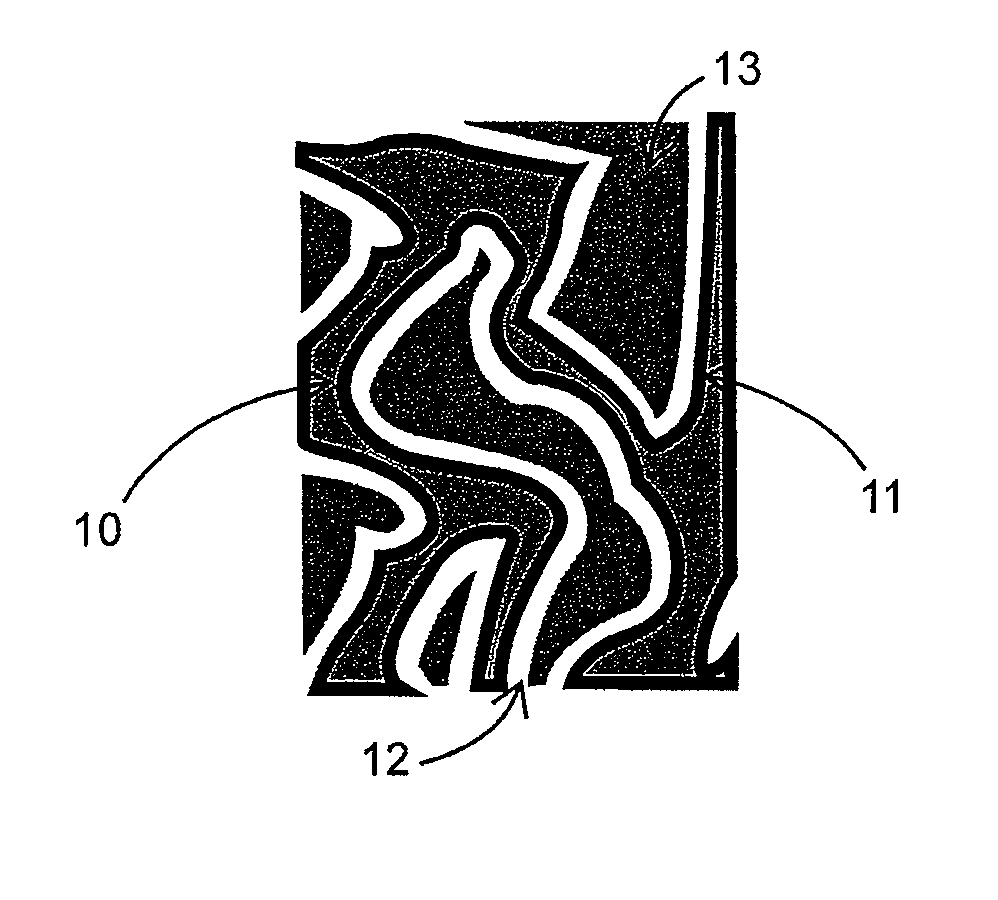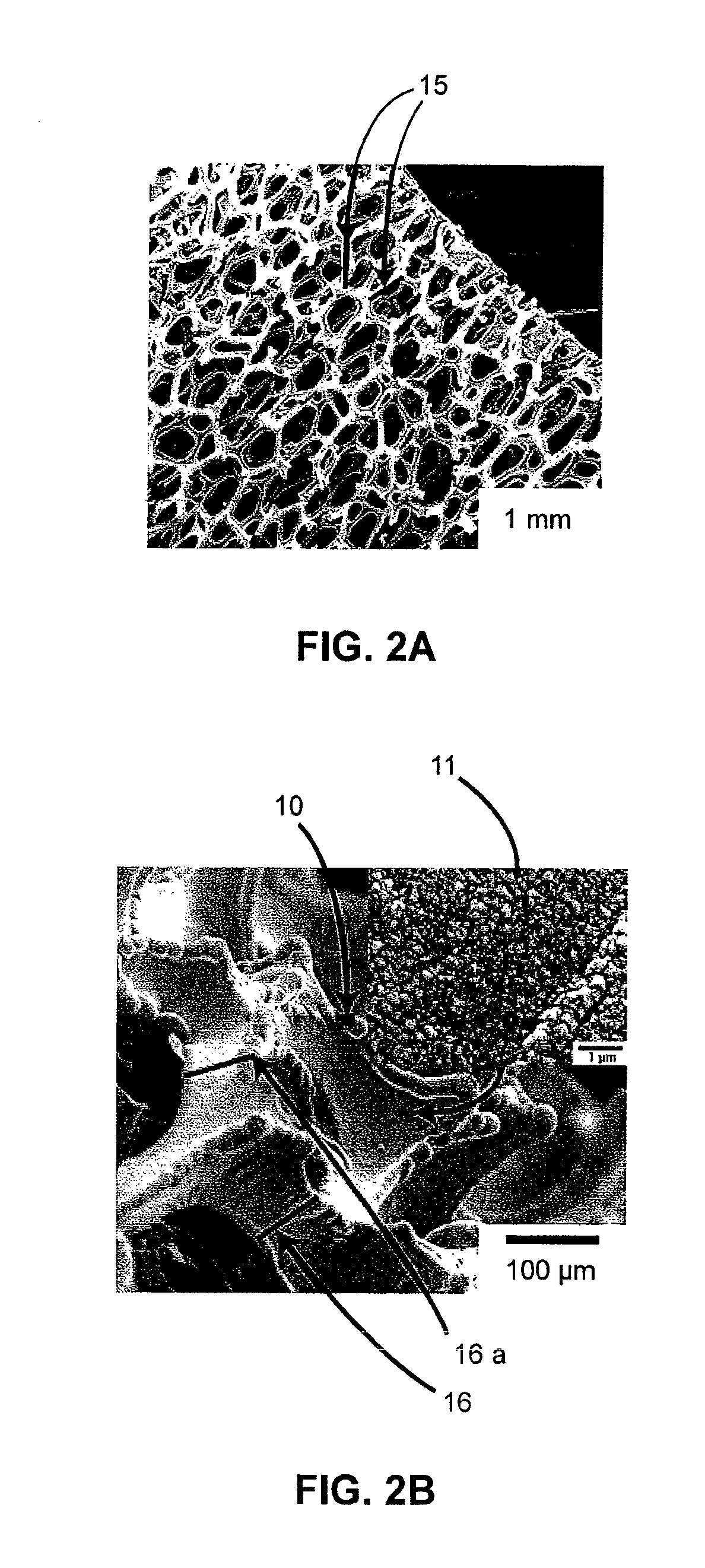Lithium-ion battery having interpenetrating electrodes
- Summary
- Abstract
- Description
- Claims
- Application Information
AI Technical Summary
Benefits of technology
Problems solved by technology
Method used
Image
Examples
example 1
Anode Preparation:
[0052]A. Cu2Sb Films:
[0053]The direct electrodeposition of crystalline, stoichiometric Cu2Sb films from aqueous solution at room temperature onto copper electrodes at a single potential is first described. Cu2Sb films were electrodeposited from aqueous 0.4 M citric acid solutions (H3Cit, ≧99.5%, Aldrich) containing 0.025 M antimony (III) oxide (Sb2O3, nanopowder, ≧99.9%, Aldrich), and 0.08 M copper (II) nitrate hemipentahydrate (Cu(NO3)2, ≧99.9%, Aldrich), prepared by adding the citric acid to Millipore water (18 MΩ) followed by the addition of Sb2O3. The complete dissolution of the Sb2O3 was aided by mechanical stirring after which the Cu(NO3)2 was added. The pH was then raised to 6 by the addition of 5 M potassium hydroxide (KOH, ACS certified, Fisher). The Cu2Sb films were obtained by performing bulk electrolysis onto both sides of copper foil at 50° C. at a potential of −1.05 V versus a SSCE. A custom deposition cell having four electrodes was used to keep both...
example 2
Electrodeposition of PPZ Solid-State Electrolyte:
[0062]A. Electrodeposition of PPZ:
[0063]The electrodeposition of a phosphazene polymer onto the porous three-dimensional structure to act as a solid-state electrolyte is described. After the Cu2Sb has been electrodeposited onto or as the porous foam structure, as describe in Part B of EXAMPLE 1, the next step in the fabrication of an interpenetrating solid-state Li-ion battery is the electrodeposition of a uniform thin solid-state electrolyte onto the surface of the Cu2Sb. To accomplish this, a solution of supporting electrolyte consisting of 0.1 M tetrabutylammonium perchlorate (electrochemical grade, ≧99.0%, Fluka) in acetonitrile (anhydrous, ≧99.8%, Aldrich) with 0.05 M hexachlorocyclotriphosphazene monomer (≧99.99%, Aldrich) and 0.05 M 1,4-naphthoquinone (puriss, Fluka) crosslinker is degassed with N2 sparging. In the absence of crosslinking, hexachlorocyclotriphosphazene was found to polymerize in a pseudo-two-dimensional network...
example 3
Cathode Preparation:
[0069]A. LiMn1.42Ni0.42Co0.16O4 Synthesis:
[0070]The results of the synthesis and characterization of Si(IV) doped LiMn1.42M0.42Co0.16O4 are described. Nanoparticles of LiMn1.42Ni0.42Co0.16O4 doped with Si(IV) were synthesized at approximately 25° C. and 630 torr. In a typical synthesis, 38.7 mmol manganese(II) acetate tetrahydrate (MnAc, 98%, Aldrich), 11.4 mmol nickel(II) acetate tetrahydrate (NiAc, ≧98%, Aldrich) and 4.37 mmol cobalt(II) acetate tetrahydrate (CoAc, Riedel-de Haen) were dissolved in Millipore water (18 MΩ×cm at about 25° C.) by stirring vigorously for approximately 30 min. Simultaneously, 164 mmol potassium hydroxide (KOH, ACS grade) was dissolved in Millipore water by stirring. Once it was confirmed by visual inspection that all of the solid precursors are dissolved, the solution containing the KOH was quickly poured into the solution containing the transition metal acetates. The rapid addition of KOH into the acetate solution is necessary to i...
PUM
 Login to View More
Login to View More Abstract
Description
Claims
Application Information
 Login to View More
Login to View More - R&D
- Intellectual Property
- Life Sciences
- Materials
- Tech Scout
- Unparalleled Data Quality
- Higher Quality Content
- 60% Fewer Hallucinations
Browse by: Latest US Patents, China's latest patents, Technical Efficacy Thesaurus, Application Domain, Technology Topic, Popular Technical Reports.
© 2025 PatSnap. All rights reserved.Legal|Privacy policy|Modern Slavery Act Transparency Statement|Sitemap|About US| Contact US: help@patsnap.com



